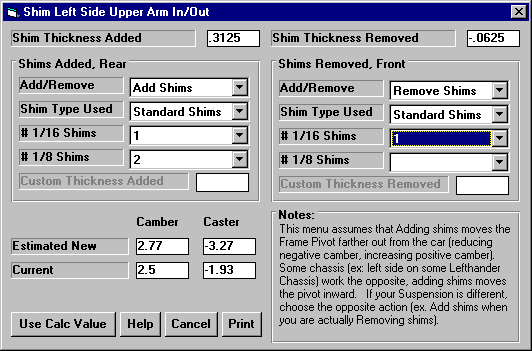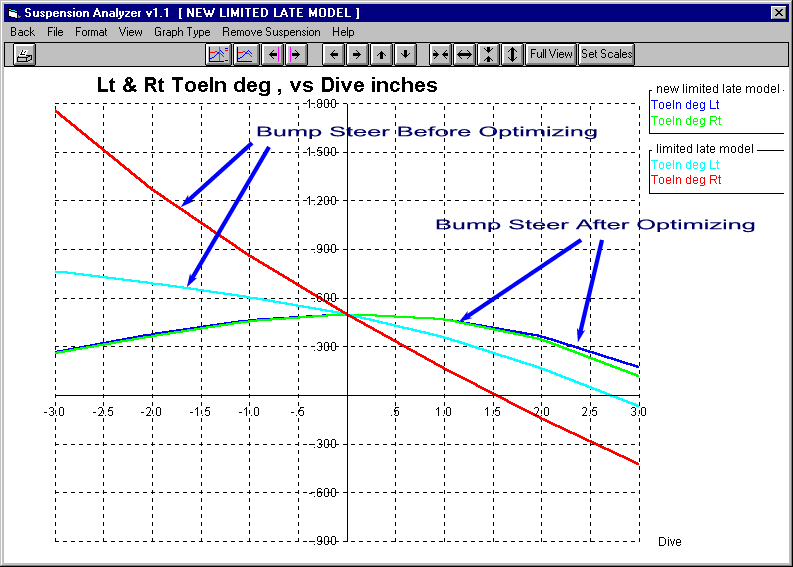
Performance Trends, Inc.
Producing Quality Computer Tools for Racers and Engine Builders since 1986
If you're a racer, race enthusiast, or engine builder with
engineering talent,  for info on joining our team.
for info on joining our team.
Suspension Analyzer v2.4 C
Computer Program for 3-D Double A-Arm (wishbone) Suspension Analysis. Standard Version 2.4 offers front suspension analysis of Double A Arm (double wishbone) or McPhearson Strut suspensions. Full Vehicle version combines front and several types of rear suspensions together for full "roll couple" analysis, or analyze front or rear separately for rear roll steer, pinion angle change, anti-squat, etc. Full Vehicle version also includes push rod and pull rod springs for double A Arm suspension.
for Windows XP, Vista, Windows 7, Windows 8, Windows 10, Windows 11
The program is available in 3 versions:
- Standard, front end only.
- The most popular Full Vehicle, which includes front and rear suspensions combined for handling analysis, and additional features.
- Full Vehicle with Data Logger (most advanced, with one of its main features lets you import data from our DataMite III and DataMite 4 data loggers, or
ASCII data files from other popular data loggers).
 for a list of all this version's extra features.
for a list of all this version's extra features.
![]() for the latest features in v2.4 C.
for the latest features in v2.4 C.
![]() for the latest features in v2.4 B.
for the latest features in v2.4 B.
![]() for
the Suspension Analyzer Comparison Table to
compare this program with our other Suspension Analysis
programs.
for
the Suspension Analyzer Comparison Table to
compare this program with our other Suspension Analysis
programs.

Typical Rear Suspension screen, here analyzing an angled 4 link rear suspension and driveshaft movement and U joint angles.

The Suspension Analyzer does a complete 3D suspension analysis, including bump steer, Ackerman, caster gain, Anti Dive, tire scrub, Camber Gain and much more. Complete graphs and reports are included, and several new features not found in other programs:
The Shim menu where you can shim the upper A-Arms up/down/in/out and see the effect on Camber & Caster.
Another feature is letting the program find optimum settings automatically with its Optimize feature. First, tell program what you want to change, and what you are looking for during what type of suspension motion. The program finds best solution and asks if you want to keep it. Using the graph features, check how much better the "optimum" setting is compared to what you started with.
The ability to change Ride Height either by Jacking on the Spring, Changing Tire Size, or Changing Spindle Drop.
Detailed determination of Wheel Rate and Roll Stiffness.
Build user designed reports and graphs for most calculated results at various levels of Dive, Roll and/or Steer.
Some of the calculated results available include:
- Spring/Shock/Sway Bar Motion Ratio
- Camber, deg
- Caster, deg
- Caster Trail
- Toe In, deg and inches
- Tire Scrub
- Ideal Ackerman Toe In, deg
- Ackerman Error, deg
- King Pin Angle, deg
- Scrub Radius
- Spindle Angle, deg
- Instant Center Height
- Instant Center Left
- Roll Center Height
- Roll Center Left
- Roll Stiffness, ft-lbs/deg
- Anti Dive, %
Most all these parameters can be checked statically and dynamically as Dive, Roll and/or Steer change.
Other features include:
- View car from front perspective or rear (driver’s) perspective.
- View suspension from front (or rear), top and side.
- Simulate Rack and Pinion or Pitman Arm/Idler Arm/Center link steering systems.
- Draw Extension Lines to see how Instant Centers and Roll Centers are derived.
- Zoom in on the suspension layout drawing, or move the drawing up, down, left or right.
- Automatically calculate and display Camber Gain, Caster Gain, Toe Gain (bump steer) as measurements and locations are changed and updated.
The Full Vehicle version adds these important features:
- Add (or analyze separately) several types of rear suspensions, including:
- Double A Arm (wishbone)
- MacPhearson Strut
- 4 Link (angled links)
- 3 Link, top link Right side w lateral locator
- 3 Link, top link Left side w lateral locator
- 4 Link with lateral locator
- Ladder Bar with lateral locator
- Truck Arms with lateral locator
- Gen III (63-82) Corvette
- Rear IRS w Lower
- H Arm (T Bird, Mustang Cobra, etc)
- Solid Axle w Leaf Springs
- Torque Tube Live Axle (added with v2.4)
- Torque Arm Live Axle (added with v2.4)
- Trailing Arm and Semi-Trailing Arm Independent (added with v2.4)
- 5 Link Independent (added with v2.4)
- Decoupled Live Axle (bird cage) (added with v2.4)
- Two styles of "lateral locators"
- Panhard Bar (J bar)
- Watts Link
- Roll Couple analysis including:
- Calculating traditional Front to Rear Roll Couple
- Calculating splits of Front Lateral Load Distribution (a more detailed and accurate Roll Couple analysis taking jacking forces into account)
- Calculating how to change roll bar rates, Spring Rates and roll center locations to achieve desired splits of Front Lateral Load Distribution (to "balance" your car's handling)
- More spring options for front and rear, including:
- Leaf Springs (on rear solid axles only)
- Torsion Bars
- Rocker Arm (spring inboard of the arm pivot point)
- Pushrod with a bell crank
- Pullrod with a bell crank
- Coil spring mounted to upper A arm
- Calculations associated with the rear suspension (or these rear suspension types) and how these parameters change as you go through dive and/or roll:
- Pinion angle
- Pinion U joint angle
- Transmission U joint angle
- Driveshaft Length
- Anti Squat
- Binding Error (the amount of distortion in the mounting hole locations on the frame to allow the suspension to move in the desired fashion)
- Roll Steer (toe change)
Note: There are nearly an infinite types of suspensions which can be designed, but not all possible suspension types can be simulated by the program. It is recommend you run the demo and see if your particular type of suspension can be simulated. Also, not all features shown are included in the Standard (front end only) version.

The more advanced "Full Vehicle with Data Logger" version adds these important features:
- Animate from data logger data lets you import data logger files containing
shock and steering travel, RPM, distance, etc to show you how the suspension
is operating out on the track. This is truly a power full feature to
analyze your data logger data. The Suspension Analyzer can even draw
your track map from vehicle speed data and left and right acceleration
data.
 to
view a movie on how this works with our own DataMite data loggers.
to
view a movie on how this works with our own DataMite data loggers. - Display 2nd order coefficients for graphed data. Some users have applications which need 2nd order curve fit coefficients (A + B*x + C*x^2) for camber curves, bump steer (toe change), etc for use in other data files. Click on Format in the graph screen, then 2nd Order Coefficients for these numbers to be displayed on a text file.
- Import tabular data for suspension measurements in X, Y and Z coordinates (like data obtained from a Faro arm system).
- Adjust or change the front A Arms based on standard NASCAR measurement standards. NASCAR teams use a standard rig for determining Arm Length (horizontal or on the installed angle) and Offset (distance ball joint is ahead of the center of the arm).
- "Ball Joint Wizard" screen for "calculating" where the exact ball joint location is from various easily measured points on the ball joint (like end of the threaded stud) and the installed angle. We've also preloaded measurements for popular ball joints (K 727, K 772, K 6141, K 7025, K 6145, K 5103, K 6117). See figure below. (We made this standard in all 2.4 versions.)
- "Ball Joint Bind" feature. You can enter ball joint info and see if the suspension movement is pushing the ball joint angle beyond the maximum angle allowed by the ball joint.
Suspension Analyzer Full Vehicle with Data Logger version's Ball Joint
Wizard screen. Now standard in all versions.

Suspension Analyzer Full Vehicle with Data Logger version's Ball Joint
Bind Feature
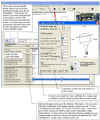 click image to enlarge
click image to enlarge ![]() for the v2.4 C supplement. This Ball Joint Feature is discussed on pages
3, and 21-24.
for the v2.4 C supplement. This Ball Joint Feature is discussed on pages
3, and 21-24.
Major New Features Added in V2.0, May 2006
Here are some of v2.0's new features:
- Metric inputs, and automatic conversions between English and Metric units.
- Front Lateral Load Distribution (FLLD%) is now calculated and can be optimized. FLLD% has a strong influence on vehicle "balance", or the amount of oversteer and understeer.
- Several new Optimize features have been added, including the ability to "optimize" FLLD%.
- New Suspension Options like Watts Link instead of a Panhard Bar, and Solid Axle with Leaf Springs.
- Other new spring options like Torsion Bars, Rocker Arm Springs (coil overs mounted inside of the A arm pivots), and coil overs which can be mounted to the upper A arms.
- New Animate features to read more types of Data Logger files, like data
from Pi, Motec and AIM.
 for info on this feature. (Only available in the "Data
Logger" version.)
for info on this feature. (Only available in the "Data
Logger" version.) - And many more
![]() for the User
Manuals PDF file discussing just these New Suspension Analyzer Features added for
v2.0 in Appendix 6.
for the User
Manuals PDF file discussing just these New Suspension Analyzer Features added for
v2.0 in Appendix 6.
Major New Features Added in V2.4, February 2010
Here are some of v2.4's new features:
- Several new rear suspension types added, including:
- Torque Tube Live Axle
- Torque Arm Live Axle
- Trailing Arm and Semi-Trailing Arm Independent
- 5 Link Independent
- Decoupled Live Axle (bird cage)
- Added several 4 Link features so you can specify all holes in your brackets and sort through all the combinations for best anti-squat or roll steer. See below.
- Added "Virtual Scales" so you can watch corner weights and cross weight change by jacking on springs, changing tire size or moving weight around. See below.
- Now all versions include the Ball Joint Wizard shown above.
- You can now draw the suspension layout drawing much larger.
- You can now click on a point in the suspension layout drawing and have that input highlighted in the input grid.
![]() for the User
Manuals PDF file discussing just these New Suspension Analyzer Features added for
v2.4 in Appendix 7.
for the User
Manuals PDF file discussing just these New Suspension Analyzer Features added for
v2.4 in Appendix 7.
4 Link Screen to Pick Combos
 click image to enlarge it
click image to enlarge it
Corner Weights Virtual Scales
 click image to enlarge it
click image to enlarge it
Major New Features Added in V2.4 B, May 2017
Here are some of v2.4 B's new features:
- The program has 2 new steering options:
One is where the steering is a steering box, there is no center link. Instead the tie rod on the spindle from one side is tied directly to the steering box arm. Then the tie rod from the other spindle is effectively tied to spindle that the steering link is attached to. This is the steering of some Jeep solid axle front suspensions.
The second is where the steering is a steering box, but the tie rods do not attach to the center link. Instead they attach to arms on the steering box and idler arm on arms on opposite side of the center link arms. This is the steering of some Alfa Romeo suspensions.
- You can now use a panhard bar or a watts link with leaf springs as the Lateral Locator.
- The program has new inputs in Vehicle Specs for front, rear or all wheel drive (what percent of the power is being delivered through the front drive tires), inboard or outboard brakes, unsprung weight.
- There are new Calculation Utility "Clc" screens calculating King Pins dimensions for solid axle front suspensions, and bump springs (including "stacked springs").
- The program now allows you to specify what the opposite end of the car is doing. This lets you apply "pitch" to the car to see what happens to the calculations.
- You can now enter specs for bump springs for the front and/or the rear suspension. (This feature is not available for push or pull rod type suspensions.)
- The program now calculates and displays new outputs, like Bump Spring Force and Dynamic (after dive and roll are applied) Roll Stiffness, Roll Couple, Front and Rear Lateral Load Transfer, and Natural Frequencies. This is very handy to watch what happens once the Bump Springs are encountered with suspension movement.
- There are new inputs for Ride Height. You can then watch Ride Height change when you apply Bump and Roll and the new Pitch input to the suspension. When you do a top view of the suspension, the location where the Ride Height measurements are made are drawn as small boxes. These measurement locations are located in the Vehicle Specs screen, as they always have been.
- You can now include a picture file with the suspension which will be drawn on the main screen if there is room, and included in printouts of reports or graphs as you direct.
- The program has new print options for graphs and reports of including the suspension picture file (if any), data table, and various customization of comments and labels.
- The program now reads some types of Bill Mitchell’s WinGeo (.gem) files, like double a arm and McPhearson strut.
- There have been several updates to Emailing Preferences to work better with modern changes to emailing protocols.
- The program now remembers some inputs you have entered in the "Clc" calculation utility screens, like for spring rate, roll bar rate, and the new Unsprung Weight, and more. These are saved with the file, so in the future you will know where, say, the roll bar rate came from.
![]() for the User
Manuals PDF file discussing just these New Suspension Analyzer Features added for
v2.4 B.
for the User
Manuals PDF file discussing just these New Suspension Analyzer Features added for
v2.4 B.
Solid Front Axle Analysis
 click image to enlarge it
click image to enlarge it
Alfa Romeo Steering
 click image to enlarge it
click image to enlarge it
Handling Ratings change significantly when Bump Springs are encountered on
Front Suspension
 click image to enlarge it
click image to enlarge it
Major New Features Added in V2.4 C, Aug 2020
Here are some of v2.4 C's new features:
- The program now finds the Force Based Roll Center, which is more accurate than the previous Kinematic Roll Center. A Preference lets you switch back to Kinematic Roll Center if you want.
- You can now use a Jacob's Ladder for a lateral locator, or a Di Dion rear suspension option.
- You can specify the CV or U Joints for half shafts for either the front or rear independent suspensions and watch the "stretch", to see how much the splines will move.
- History Log allows for a new way to find and open files, where the most recent files you have worked with are at the top of this list.
- The History Log also allows you to specify several different files for doing graphs, letting you compare more than just 2 suspensions on a graph.
- The program displays the spring, bump spring, and anti-roll bar forces.
- You can enter shock dyno data and several ways to enter shock velocity data, and display the shock forces for these velocities. Handling ratings will also be adjusted by including these shock forces.
- A new "Watch Rows" feature lets you pick up to 6 of the output rows to be displayed directly under the drawing. This way you do not have to scroll down through all the data to watch the outputs you are interested in as the vehicle goes through Dive, Roll, etc.
- There are several new and more accurate anti-roll bar options for calculating roll bar stiffness, including the new "blade anti-roll bar".
- "Ball Joint Bind" feature. You can enter ball joint info and see if the suspension movement is pushing the ball joint angle beyond the maximum angle allowed by the ball joint. Available in Data Logger version only.
![]() for the User
Manuals PDF file discussing just these New Suspension Analyzer Features added for
v2.4 C.
for the User
Manuals PDF file discussing just these New Suspension Analyzer Features added for
v2.4 C.
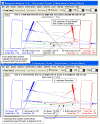 click image for Force Based Roll Center info
click image for Force Based Roll Center info
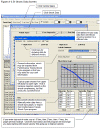 click image for Shock Dyno Data Input screen
click image for Shock Dyno Data Input screen
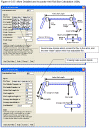 click image for new Anti-Sway Bar options
click image for new Anti-Sway Bar options
Accessories:
Want Help Measuring Your Suspension:
Unijig (tm) makes a measuring system which can greatly help in measuring out your suspension. Click on this link for more info: Uni Jig
What You Need:
Computer with Windows XP, Vista, Windows 7, Windows 8, Windows 10, Windows 11.
What You Get:
Program CD with 180 page manual in PDF format on the CD. Several example suspension files preloaded in the Example library for you to start with. You get 2 license keys (code numbers) to have the program on 2 computers at the same time. Additional sites can be added at a nominal charge.
Note: There are nearly an infinite types of suspensions which can be designed, but not all possible suspension types can be simulated by the program. It is recommend you run the demo and see if your particular type of suspension can be simulated. Also, not all features shown are included in the Standard (front end only) version.
More Information, Download Demo:
![]() to
go to our Demo Downloading page to download a FREE Suspension Analyzer Demo.
to
go to our Demo Downloading page to download a FREE Suspension Analyzer Demo.
More Information, Watch Demo Movies:
![]() to
go to our Demo Movie page to watch Suspension Analyzer Demo Movies, including sending
data to the Suspension Analyzer program.
to
go to our Demo Movie page to watch Suspension Analyzer Demo Movies, including sending
data to the Suspension Analyzer program.
![]() for
the Suspension Analyzer Comparison Table to
compare this program with our other Suspension Analysis
programs.
for
the Suspension Analyzer Comparison Table to
compare this program with our other Suspension Analysis
programs.
![]() to see Readme.doc file, or
to see Readme.doc file, or
![]() to view a PDF file of the latest improvements.
to view a PDF file of the latest improvements.
![]() to see Readme.doc file, or
to see Readme.doc file, or
![]() to view a PDF file of the latest v2.4 B
improvements.
to view a PDF file of the latest v2.4 B
improvements.
To Order:
Our DOWNLOAD ONLY option. If you only want the unlocking code and DO NOT want a CD shipped, click on Add to Cart below. You will not be charged shipping.If you want a CD shipped to you, click on Add to Cart below. There will be shipping charges added to your order. You can still download the demo and get your unlock code sooner with this option.
To order a CD with a PRINTED manual, click on Add to Cart. Manuals are included on the CD's but in PFD format. You can still download the demo and get your unlock code sooner with this option.
Suspension Analyzer Full Vehicle:
Our DOWNLOAD ONLY option. If you only want the unlocking code and DO NOT want a CD shipped, click on Add to Cart below. You will not be charged shipping.If you want a CD shipped to you, click on Add to Cart below. There will be shipping charges added to your order. You can still download the demo and get your unlock code sooner with this option.
To order a CD with a PRINTED manual, click on Add to Cart. Manuals are included on the CD's but in PFD format. You can still download the demo and get your unlock code sooner with this option.
Call 248-473-9230. Visa or Mastercard accepted.
![]() for more price and ordering info.
for more price and ordering info.
